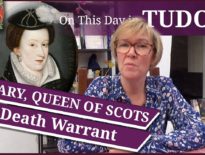On this day in Tudor history, 2nd February 1550, Sir Francis Bryan, died suddenly in Ireland. He was a rather colourful Tudor character, known as much for his drinking, gambling and all-round bad behaviour, as his diplomacy, royal favour and gift for poetry.
Find out more about this one-eyed courtier and his nickname, "the vicar of hell", in today's talk.
Book recommendation: Sir Francis Bryan, Henry VIII's most notorious ambassador, by Sarah-Beth Watkins.
Today is also Candlemas, and you can find out more about that feast day and how it was celebrated in Tudor times in my video from last year:
Also on this day in history:
- 1508 – Death of John Argentine, physician and Provost of King's College, Cambridge. He died at King's College and was buried there in the Chantry Chapel. Argentine was physician to Prince Arthur, son of Henry VII, and was also said to be the last man to attend on the Princes in the Tower.
- 1575 – Death of John Parkhurst, Bishop of Norwich, probably at Ludham, Norfolk. He was buried in the nave of Norwich Cathedral. He had become Bishop of Norwich in 1560, after his return to England from exile in Mary I's reign. Parkhurst was Chaplain to Queen Catherine Parr, and also to Charles Brandon, Duke of Suffolk, and his wife, Katherine (née Willoughby).
- 1597 – Burial of James Burbage, joiner, actor and theatre builder, in Holywell Street, Shoreditch. Burbage acted in Leicester's Men and built “The Theatre”, a playhouse in Shoreditch, with his brother, Robert.
- 1597 – Death of James Morice, lawyer and member of Parliament. He hoped to be made Attorney-General, but he angered Elizabeth I in 1593 by causing a heated debate in Parliament when he claimed that church courts were acting against the “Magna Carta”. He was temporarily put under house arrest.
Transcript:
On this day in Tudor history, 2nd February 1550, in the reign of King Edward VI, the courtier, diplomat and poet nicknamed “the Vicar of Hell”, Sir Francis Bryan, died suddenly at Clonmel in County Tipperary, Ireland.
Let me tell you a bit more about this colourful character...
Sir Francis Bryan was born in around 1490 and was the first surviving son of Sir Thomas Bryan and Lady Margaret Bryan (née Bourchier). His mother served Queen Catherine of Aragon as a lady-in-waiting and then served as governess to Henry VIII’s children, Mary, Elizabeth and Edward. Lady Bryan was related to Anne Boleyn, being the half-sister of Elizabeth Howard, Anne’s mother.
Historian Susan Brigden believes that Bryan may have spent some of his youth in the household of Sir Thomas Parr of Kendal, Westmorland, in Northamptonshire because Bryan later referred to Parr as his patron. Parr was the father of Queen Catherine Parr.
Sir Francis Bryan was a court favourite. He served as the king’s cupbearer in 1516, and became a gentleman of the Privy Chamber in 1518, only to lose his position in Cardinal Wolsey’s purge in 1526. He regained it in 1528.
Bryan was knighted in 1522 for his courage during the capture of Morlaix in Brittany, serving under the Earl of Surrey. By 1526 he held the position of chief cupbearer and master of the henchmen.
He was known for his skills at jousting and hunting and became the King’s master of the toils in 1518, a position he held for the rest of Henry VIII’s reign. He suffered a nasty jousting accident on 7th February 1526, at the Shrovetide joust at Greenwich. Chronicler Edward Hall recorded that the “shivering”, i.e. splintering, of a spear caused Bryan to lose an eye. Bryan was also known for his rich clothing and had a reputation for gambling. Like his friend, Thomas Wyatt the Elder, he was also a poet, although we do not have any poems today that we can safely ascribe to him, although one called “The proverbes of Salmon” has been suggested as his.
Bryan also acted as a patron of the arts and a patron to scholars of Greek who worked on translating scripture.
He served as Henry VIII as a diplomat during the king’s ‘Great Matter’, and Susan Brigden writes of how he became known for “his unusual willingness to tell the king the truth, but also for his employment of dubious means to gain diplomatic ends”, and writes of how he slept with a courtesan at the papal court to gain intelligence.
In May 1536, Bryan he was called to London to be interrogated as part of the ‘investigations’ during Anne Boleyn’s fall. He was allied with the Seymours by this point and some see his interrogation as a ruse to add credibility to the proceedings; he was not imprisoned and was chosen by the king to go and tell Jane Seymour the news of Anne Boleyn’s execution. He benefited from Anne Boleyn’s fall, becoming Chief Gentleman of the King’s Privy Chamber.
Thomas Cromwell referred to Bryan as “the vicar of Hell” in a letter to Gardiner and Wallop on the 14th May 1536. According to Catholic recusant Nicholas Sander, the king also referred to him by this nickname. Sander writes “This man was once asked by the king to tell him what sort of a sin it was to ruin the mother and then the child. Bryan replied that it was a sin like that of eating a hen first and its chicken afterwards. The king burst forth into loud laughter, and said to Bryan, ‘Well, you certainly are my vicar of hell.’ The man had been long ago called the vicar of hell on account of his notorious impiety, henceforth he was called also the king’s vicar of hell.”
In 1537 he was sent to Paris to secretly arrange the kidnap or assassination of Cardinal Pole but it was suspected that he actually tipped Pole off. In 1539, Bryan sat on the jury which found his brother-in-law, Carew, guilty of treason.
Bryan served as ambassador at Francis I’s court in 1538, but was recalled due to his reckless gambling, drunkenness and all round bad behaviour. He never acted as ambassador to the French king ever again. He was appointed Vice-Admiral in 1543 and served as the English ambassador to Charles V in 1543. He was made Knight-Banneret in 1547 for his role in the expedition against the Scots as commander of the horse.
Bryan was married twice. By 1522, he had married Philippa, daughter and heir of Humphrey Spice and widow of John Fortescue of Ponsbourne in Hertfordshire. The marriage was childless. After Philippa’s death in 1542, he took Thomas Wyatt’s satirical advice and found himself a wealthy widow to marry, marrying Joan Butler, dowager countess of Ormond, and daughter of James fitz Maurice Fitzgerald, tenth earl of Desmond, in 1548. He made Ireland his home after this marriage, and was appointed Lord Marshal in January 1549, leading King Edward VI’s forces in Ireland. His marriage and position as Lord Marshal made him a very powerful man in Ireland.
He was also Lord Justice in December 1549, and travelled to Tipperary in that position “to check the incursions of the O’Carrolls”. However, he died there on 2nd February 1550. His last words were said to be: “I pray you, let me be buried amongst the good fellows of Waterford (which were good drinkers).”
Bryan’s motto was Je tens grace (‘I look for salvation’) and he was a staunch Catholic.



So much for his anti Pope stance in the Tudors. Although he had no qualms about King first, even if he did tip Cardinal Pole of. Trying Nicholas Carew could not have been easy. Glad to see a biography at last. Download yesterday.👍
Marry a Fitzgerald, the bain of the Tudors. I love that. The Earls of Desmond had raised hell against them for years. They had been loyal but were betrayed and turned on, almost destroyed. They supported Simnel, then they were the real power in Ireland, then Silken Thomas raised his banners against the Supremacy until forced to surrender, he fell under the axe with seven brothers and cousins. However, the clan recovered and this was an odd but profitable move for Sir Francis Bryan, one eye and all.
Henry had called him his vicar from hell as a joke and some the Black Pope, because he was dark and swarthy in looks, no doubt. I have an image of him looking a bit like a pirate King with an earring as in the Tudors. I bet he was a lovable rogue. I am not sure seeking the advice of Thomas Wyatt on marriage is a good idea, but he did get the rich heiress/widow he had always wanted.
I know one thing, from posts on the Anne Boleyn files Sir Francis Bryan has a lot of descendants or collateral descendants.
What a character, Sir Francis Bryan. But I am intrigued by the suspicion regarding him tipping off Cardinal Pole (and that he was a staunch Catholic, well, as much of a staunch Catholic someone whose known as the Vicar of Hell could be).
Claire, this year the groundhog in Pennsylvania, near where I live, did not see his shadow. We’re in for an early spring. One can only hope… Michelle t
I want to know the sources for Francis Bryan having a son, legitimate or not.
There is a lot of confusion around this as he had no children with his first wife.
He is believed by some people to have a mystery son called Edmund, by others to have an illegitimate child, by many others to have had a legitimate son by Jane Fitzgerald,
by Jane Fitzgerald, the daughter of the Earl of Desmond, the rich woman he married, a Francis Bryan II who married an Anne Smith from whom all these people claiming descent. He was born in 1549,_the year before Francis died. No contemporary sources give clear evidence of any children but some later accounts in the archives apparently mentioned him.
I would really love to know if this was true as so many people claiming to be his descendants and its a mystery.
I agree. Supposedly our Bryan/Bryant family is descended from his son, Francis, who married smith.
How in the world did he survive The Great Matter as a staunch Catholic, and even find favor at court? He may have been a staunch Catholic, but I imagine he sold his soul to the devil and would do anything to keep his head 😂😂😂
Hi Claire, the above site Real Royalty is it a new site of yours ?
Hi Lynne,
What do you mean “the above site”? I can’t see any mention of Real Royalty in this post. Now, I’m confused lol! Is it perhaps some advertising you’re seeing on YouTube? It’s not me!
I am perplexed at the thought of him people a staunch catholic and surviving the the Great Matter as well and being so close to Henry. However, one only has to look for example of Nicholas Carew being around Henry and actually not being a true supporter of Anne. He obviously hid that so well and managed to stay so very close to Henry and even help plot Anne’s downfall. The ironic thing is Henry had him executed only a year or two after Anne’s death.